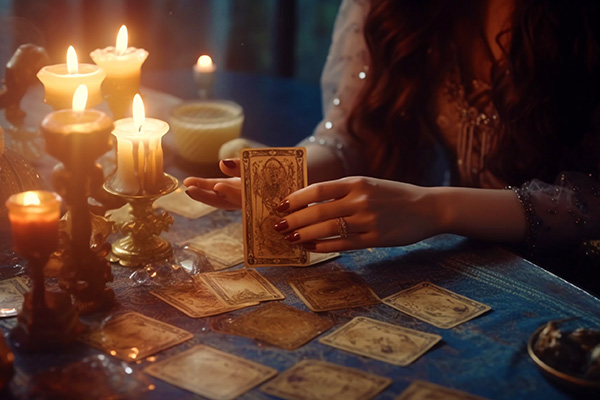A Manual for Accepting Your Shadow Self
 Many individuals commonly shy away from confronting their dark or “shadow” aspects in the realm of spirituality.
Many individuals commonly shy away from confronting their dark or “shadow” aspects in the realm of spirituality.
Indeed, the habit of evading uncomfortable features of the self largely arises from our spiritual or religious upbringing. Historically, many cultures have urged individuals to stifle, reject, or rise above their human imperfections in pursuit of elevated concepts like purity, salvation, or enlightenment.
This hesitance to confront the shadow within us persists still, as contemporary spiritual and metaphysical groups frequently emphasize light, love, and positivity while largely neglecting the chaotic, challenging, and painful dimensions of human existence.
However, by dodging the shadow within, we forfeit the chance for a richer comprehension of our soul’s mission and uncharted opportunities for personal and spiritual development.
As Carl Jung, the renowned Swiss psychiatrist who introduced the concept of the “shadow” in psychology, observed, “One does not become enlightened by imagining luminous figures, but by making the darkness conscious. Enlightenment does not stem from shunning the shadow; rather, it’s about facing it and incorporating it into our essence.
Confronting the shadow within allows us to reclaim parts of ourselves that possess great strength, creativity, and insight. By exploring the deeper realities of our shadow selves, we can discern the unconscious patterns that govern our lives, facilitating genuine healing, transformation, and enlightenment.
Thus, our spiritual journey demands that we welcome both the light and the dark within, for it is in this fragile equilibrium that genuine wisdom is attained.
How can I be significant if I do not cast a shadow? I must have a dark side as well if I am to be complete ~ C.G. Jung
Understanding The Shadow Self
So, what do we mean by our shadow? Essentially, it represents the dimensions of ourselves that we often conceal, not just from others, but also from ourselves. Broadly speaking, anything we classify as unacceptable to society or our social network tends to be relegated to the recesses of our minds and the depths of our souls.
The shadow embodies those facets of our identity we reject, deny, or mask because we perceive these traits as undesirable, socially unacceptable, or spiritually forbidden. In simpler terms, it encompasses all our suppressed emotions, unresolved trauma, shame, hidden fears, and negative attributes.
While the notion of a “shadow side” may appear to be dark or unfavorable, the shadow itself is not inherently harmful. Indeed, it embodies both destructive and constructive aspects. The shadow can contain emotions and traits we’ve kept at bay, such as anger, jealousy, or fear, but it also holds latent strengths like creativity, passion, and assertiveness.
In some instances, the shadow may also comprise our undiscovered abilities and unmet potential, referred to as the “golden shadow.” While the shadow typically pertains to the darker, hidden elements, the golden shadow encompasses the positive attributes and potential we suppress or unconsciously project onto others. These qualities are often traits we admire in other people but may struggle to recognize or accept within ourselves.
Why do we choose to hide or stifle these valuable traits? A common explanation is the subconscious fear that allowing our talents and gifts to shine may provoke envy, isolation, failure, or even mockery from family and friends. Yet, if we muster the courage to welcome the divine purpose and strength residing within us, we can unlock significant personal accomplishments and contribute to a better world by confidently sharing our gifts. How about that?
Embracing our shadow necessitates insights into our concealed aspects, accepting them, and merging them into the conscious self. Although confronting our shadow might seem daunting or uncomfortable, this is an essential step in revealing deeper insights about ourselves, reclaiming our completeness and inner divinity. It can lead to substantial healing, self-actualization, and mastery of the spiritual self.
Every person carries with them throughout life a mirror, as unique and impossible to discard as their shadow ~ W.H. Auden
How To Engage In Shadow Work
So, how do we proceed with embracing and healing the shadow? This can be accomplished through the transformative practice known as “shadow work,” which focuses on assimilating and healing the shadow. Frankly, this is often easier said than done, as it requires time, effort, commitment, and yes, a measure of courage and perseverance along the way. Nonetheless, the benefits can be immense.
Building on the psychological theories of Carl Jung, shadow work entails confronting uncomfortable emotions, behaviors, and traits that you may have buried in your unconscious. By illuminating these aspects, you can gain deeper insights into yourself, leading to emotional healing, personal development, and spiritual evolution.
Jung’s contributions established the groundwork for the practice, which has been further refined by contemporary practitioners and educators such as Cliff Barry, who established Shadow Work® in the late 1980s, along with Debbie Ford, Teal Swan, Carolyn Elliott, and Lorie Ladd, among others. Debbie Ford’s book, The Dark Side of the Light Chasers (1998), significantly popularized the core principles of traditional Shadow Work in a manner unlike any previous efforts.
Over the last thirty years, shadow work has resulted in the formation of healing groups and training programs that have proliferated globally, assisting individuals in exploring and integrating the shadow self.
Here is a guideline to begin with basic shadow work:
STEP 1: SACRED SPACE
Shadow work necessitates that you allocate time for quiet introspection or meditation to explore your inner reality. This process may awaken profound emotions and past traumas, so crafting a secure, non-judgmental environment for this practice is essential. Designate a time and place for your shadow work practice where distractions will be minimal.
Your environment should feel safe and nurturing. Use calming music, candles, incense, and crystals to foster a serene atmosphere. Grounding meditations, prayers, visualizations, affirmations, or chants can also aid in centering your mind and preparing for the deep introspective work ahead.
Your life will be transformed once you make peace with your shadow. The caterpillar will morph into a stunning butterfly ~ Debbie Ford
STEP 2: IDENTIFY TRAITS
To begin, observe your reactions to the people and things you find displeasing. Take time to contemplate the negative traits, attitudes, and beliefs you tend to bury or ignore. These can all serve as indicators for your shadow self. This might include feelings such as anger or jealousy, or traits you find unsatisfactory, like apathy or selfishness.
Much of the shadow forms during childhood, when you learn which actions were deemed acceptable and which were not. Have an open dialogue with your inner child. Pose questions and listen for the responses. Also, reflect on the attributes you appreciate or disdain in others. These often mirror facets of yourself that you haven’t fully recognized.
STEP 3: IDENTIFY TRIGGERS
Another practical way to discover your shadow aspects is to observe your fears and emotional triggers. Triggers are situations or individuals that provoke strong, often disproportionate, emotional reactions within you. For instance, if someone’s accomplishments make you feel envious, it could disclose repressed jealousy or feelings of inadequacy. Such reactions indicate unresolved elements of your shadow that seek recognition.
Maintain a shadow journal. Document your thoughts, feelings, and reactions. Reflect on patterns and recurring motifs. Each time you experience an intense emotional response, jot it down. Contemplate why it disturbs you and what it reveals about your inner self. For example, if you have a strong reaction to a social media post regarding abuse victims because of your own past, you may harbor a fear linked to abandonment.
STEP 4: INTEGRATION
Recognizing that the shadow is a natural aspect of our existence simplifies the approach to this process with compassion and a lack of judgment. Shadow work is not about fixing or erasing these parts of ourselves; it’s about welcoming them. By doing so, we are embracing our humanity on a conscious level, which is in itself a significant personal achievement.
You may feel that “acceptance” equates to submission, but when discussing the shadow, this is far from the truth. Rather, it entails recognizing our negative attributes and triggers instead of dismissing them. We must acknowledge something consciously before we can endeavor to enhance it!
Thus, once you’ve pinpointed a shadow trait, the next move is to embrace it with compassion and understanding. You need to label each shadow trait and recognize it as an authentic component of who you truly are. This may involve engaging in inner dialogue, conversing with that aspect of yourself as you would comfort a distressed child, or expressing your creativity through writing or drawing to bring the shadow into awareness. Also, be attentive to your dreams, as they can unveil concealed elements of your inner being.
Practicing self-compassion is vital. When you confront a shadow quality, resist the impulse to criticize yourself. Acknowledge that everyone has a shadow and that healing initiates with acceptance.
Every suffering, addiction, anguish, longing, depression, rage, or fear is an abandoned part of ourselves seeking joy, some disowned shadow yearning to return to the light and home of ourselves ~ Jacob Nordby
STEP 5: SUPPORT AND GUIDANCE
Engaging in shadow work can be overwhelming, and at times, professional aid from a therapist, mental health counselor, or spiritual coach can be immensely beneficial. Consult a trusted friend or family member for their insights on your behaviors and possible blind spots. Some individuals also opt to delve into shadow work via workshops or support groups.
Psychic readings can also act as a potent ally in shadow work, illuminating facets of ourselves that may be obscured or restrained while providing a safe and supportive atmosphere, but ensure you consult a reputable and skilled psychic or medium.
Readings can assist in revealing underlying patterns, fears, unresolved emotional issues, and past-life karmic influences contributing to your shadow self. These discoveries can grant you a deeper comprehension of your inner landscape and soul journey, providing a scaffold for confronting these suppressed elements with compassion and acknowledgment.
When feeling overwhelmed or stagnant, seeking external support can offer clarity and emotional safety. Never hesitate to seek help when the shadow work becomes too daunting. There’s no shame in pursuing social support and professional assistance.
STEP 6: REGULAR PRACTICE
Shadow work is not a singular endeavor but a lifelong journey of self-awareness and evolution. It is a gradual process rather than a race to a conclusion. You won’t merely wake up one day declaring, “Hooray, I have completely embraced and accepted my shadow!” As your exploration of your shadow unfolds, newfound layers of your subconscious and karmic legacy will unfold.
Incorporate shadow work into your ongoing spiritual or self-care practices. Set intentions to confront your shadow with bravery and openness. Regularly checking in with yourself via journaling, meditation, prayer, or mindful reflection will help align you with your emotional and spiritual development.
Shadow work serves as a formidable instrument for self-discovery and healing. By recognizing and integrating aspects of ourselves that we’ve concealed or denied, we can foster enhanced emotional resilience, compassion, and spiritual progress. Approach the endeavor with patience, curiosity, and kindness, always remembering that shadow work is an enduring journey towards self-acceptance and inner tranquility.
Ultimately, while exploring our shadow self enables us to examine our flaws, it also allows us to uncover our strengths. In essence, our shadow is where the genuine truth resides, and if we can embrace and accept what is negative about us, we can certainly accept what is positive.
The truth indeed liberates us. By recognizing both the good and the less favorable aspects of ourselves, and by fostering a fearless acceptance of both, we position ourselves to truly radiate like the brilliant, beautiful souls that we truly are.
|
Lucinda is an exceptionally trained Intuitive and Empath residing in a quaint village in North Yorkshire, England. She possesses the distinctive ability to comprehend a client’s personal struggles and has encountered numerous challenges herself, which has only served to strengthen her! It is both her vocation and her joy to assist those in need. Whenever she requires guidance, her Guides are always present to support her development and provide clear insights for her clients. Prediction has consistently been a valuable tool she could rely on to accurately forecast events, but Lucinda also utilizes her expertise in Dream Interpretation, Numerology, Angel Cards, the Law of Attraction, and Life Coaching to deliver thorough and detailed solutions to any concern. A participant in AMORC and Beyond Freedom Evolution, she offers inspiration, education, and personal support for spiritual advancement. If you’re seeking answers or wish to manifest your desires, you can connect with Lucinda at PsychicAccess.com. |
















